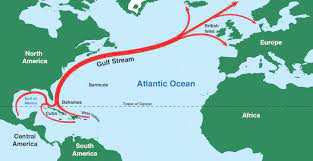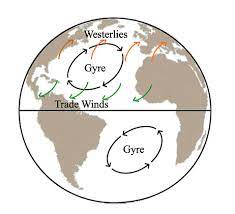The Gulf Stream is a strong and warm ocean current that flows along the eastern coast of the United States and across the Atlantic Ocean towards Europe. It is a key driver of the climate in these regions and plays an important role in oceanic and atmospheric circulation. In this article, we will explore the stream in detail, including its origin, characteristics, and importance.
The Gulf Stream is one of the most powerful and significant ocean currents in the world, often described as a “river within the ocean.” This fast-moving, warm-water current originates in the Gulf of Mexico, flows along the eastern coast of the United States, and stretches across the Atlantic Ocean toward Europe. It plays a critical role in regulating global climate, influencing weather patterns, and supporting marine ecosystems. In this blog, we’ll explore the Gulf Stream’s origins, its journey, its environmental impact, and the challenges it faces in a changing climate.
Table of Contents
What is the Gulf Stream?
The Gulf Stream is a warm, swift Atlantic Ocean current that forms part of the North Atlantic Subtropical Gyre. It begins in the Gulf of Mexico, where warm waters from the Caribbean Sea converge, and flows northward along the U.S. East Coast before veering across the Atlantic toward Europe. The current is driven by a combination of wind patterns, the Earth’s rotation (Coriolis effect), and differences in water temperature and salinity.
Key Characteristics
-
Width and Depth: The Gulf Stream is approximately 100 kilometers wide and can extend to depths of up to 1,200 meters.
-
Speed: It moves at speeds of up to 2 meters per second (about 6.5 feet per second), making it one of the fastest ocean currents.
-
Temperature: The waters of the Gulf Stream are significantly warmer than surrounding waters, often exceeding 25°C (77°F) in some areas.
The Journey of the Gulf Stream
The Gulf Stream’s path is a remarkable journey across thousands of miles:
-
Origin: It starts in the Gulf of Mexico, where warm waters are funneled through the Straits of Florida.
-
Northward Flow: The current hugs the U.S. East Coast, passing Florida, the Carolinas, and up to Cape Hatteras, North Carolina, where it begins to move away from the coast.
-
Across the Atlantic: After leaving the U.S. coast, the Gulf Stream splits, with parts of it continuing as the North Atlantic Drift, influencing the climates of Western Europe, particularly the United Kingdom and Norway.
-
Cooling and Sinking: As the warm waters reach colder northern latitudes, they cool, become denser, and sink, contributing to the global thermohaline circulation, often called the “global conveyor belt.”
Environmental and Climatic Impacts
The Gulf Stream has far-reaching effects on both local and global scales:
Climate Regulation
-
Warming Europe: The Gulf Stream carries warm water to the North Atlantic, significantly moderating the climate of Western Europe. For example, the United Kingdom enjoys milder winters than other regions at similar latitudes, such as parts of Canada or Russia, due to the heat transported by the Gulf Stream.
-
Weather Patterns: The current influences weather systems, including the formation and paths of hurricanes along the U.S. East Coast. Its warm waters provide energy that can intensify storms.
Marine Ecosystems
-
Biodiversity Hotspot: The Gulf Stream supports a rich diversity of marine life, from plankton to large fish species, by transporting nutrients and creating unique habitats.
-
Fisheries: Coastal communities, particularly along the U.S. East Coast, rely on the Gulf Stream’s nutrient-rich waters for thriving fisheries.
Challenges and Threats
Despite its strength, the Gulf Stream is not immune to the impacts of climate change:
-
Weakening Circulation: Studies suggest that global warming may be slowing the Atlantic Meridional Overturning Circulation (AMOC), of which the Gulf Stream is a part. Melting polar ice adds fresh water to the North Atlantic, disrupting the sinking of dense, salty water that drives the current.
-
Climate Consequences: A weakened Gulf Stream could lead to colder winters in Europe, altered weather patterns, and disruptions to marine ecosystems.
-
Sea Level Rise: Changes in the Gulf Stream’s flow could contribute to higher sea levels along the U.S. East Coast, exacerbating coastal flooding.
Why the Gulf Stream Matters
The Gulf Stream is more than just a current; it’s a critical component of Earth’s climate system. Its influence on weather, climate, and marine life underscores the importance of protecting our oceans. As climate change poses new challenges, understanding and monitoring the Gulf Stream is essential for predicting future environmental shifts and mitigating their impacts.

Origin of the Gulf Stream
It originates in the Gulf of Mexico, where warm waters from the Caribbean Sea flow northward along the Florida coast. As the current reaches the tip of Florida, it becomes the Florida Current, which then merges with the Atlantic Current and continues its journey across the ocean.

Characteristics of Gulf Stream
It is a strong and narrow current that is around 100 kilometers wide and up to 800 meters deep. It flows at a speed of up to 2 meters per second and carries around 30 times more water than all the rivers in the world combined. The warm waters of the Gulf Stream also influence the climate of the regions it passes through, keeping them warmer than they would otherwise be.
Importance
Gulf Stream plays a crucial role in regulating the climate of the eastern coast of the United States and Western Europe. Its warm waters transport heat from the tropics to higher latitudes, which helps to moderate the temperatures of these regions. The Gulf Stream also affects weather patterns, influencing the formation of storms and hurricanes, and it provides a habitat for a variety of marine life.
Impact of Climate Change
Climate change is affecting the the stream in several ways. Rising global temperatures are causing the polar ice caps to melt, which is adding more fresh water to the ocean. This freshwater is less dense than saltwater, so it is disrupting the flow of the stream and reducing its strength. This could have significant impacts on the climate of the regions it influences.
Conclusion
It is a powerful and important ocean current that plays a key role in regulating the climate of the eastern coast of the United States and Western Europe. As the world continues to experience climate change, it is important to monitor the health of the Gulf Stream and take action to protect it for future generations.
Read: Geography Notes